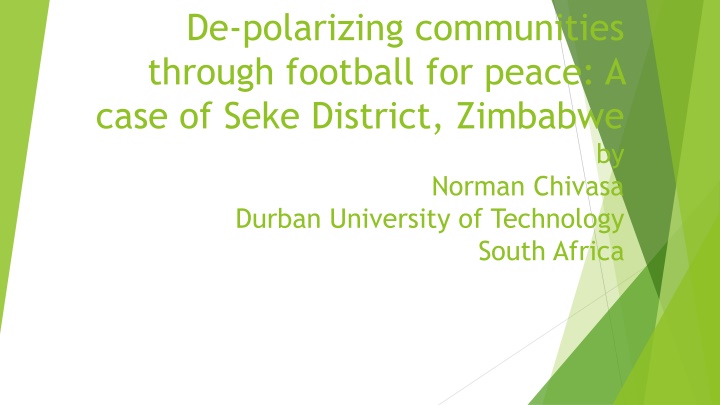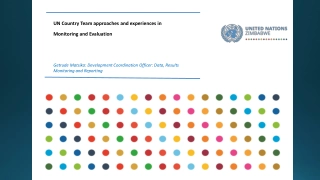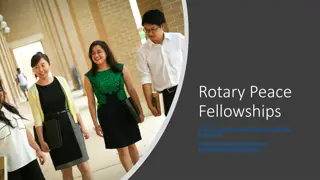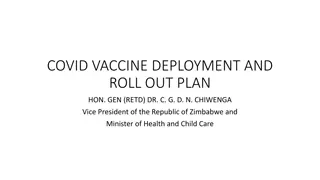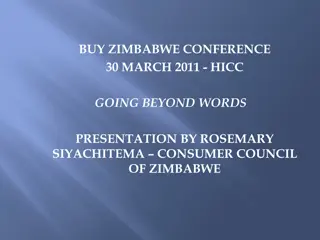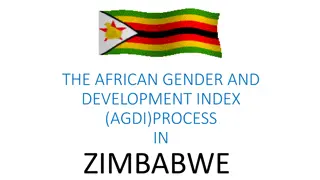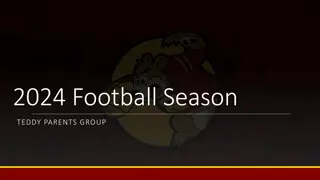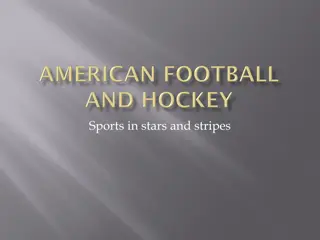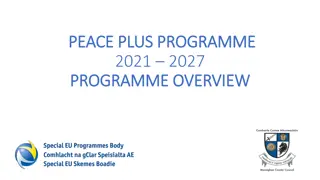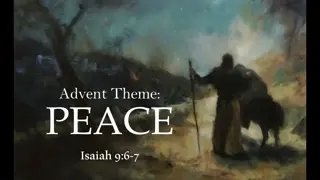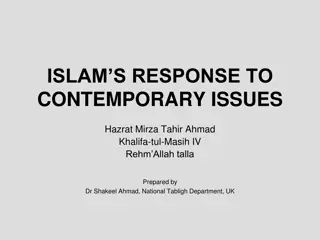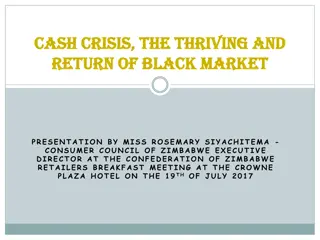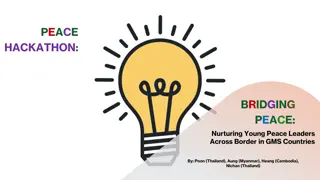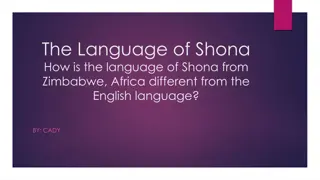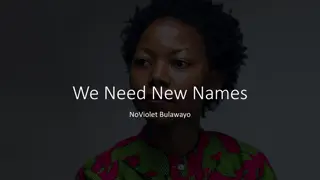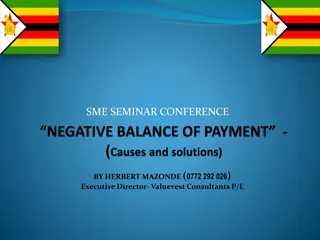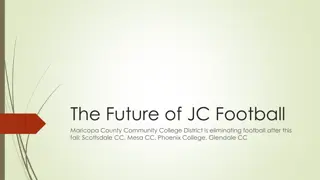De-polarizing Communities Through Football for Peace: A Case Study in Seke District, Zimbabwe
Delving into the dynamics of polarization in Zimbabwean communities, this paper explores the role of inter-party competition and politicization in fostering divisiveness. It advocates for Football for Peace (F4P) interventions as a means to reconcile and unite divided communities. While acknowledging the dual nature of football as both a unifying force and a potential source of conflict, the study presents the F4P model in Seke district as a promising initiative for promoting peaceful co-existence.
Download Presentation

Please find below an Image/Link to download the presentation.
The content on the website is provided AS IS for your information and personal use only. It may not be sold, licensed, or shared on other websites without obtaining consent from the author.If you encounter any issues during the download, it is possible that the publisher has removed the file from their server.
You are allowed to download the files provided on this website for personal or commercial use, subject to the condition that they are used lawfully. All files are the property of their respective owners.
The content on the website is provided AS IS for your information and personal use only. It may not be sold, licensed, or shared on other websites without obtaining consent from the author.
E N D
Presentation Transcript
De-polarizing communities through football for peace: A case of Seke District, Zimbabwe by Norman Chivasa Durban University of Technology South Africa
Presentation structure Introduction The nature of polarization in Zimbabwean communities The forces behind polarization Statement of the problem Past and present interventions to address polarization Football for peace theory Depolarizing communities: F4P model in Seke district Way forward ?
Introduction It is an open secret that in Zimbabwe elite divisions are mirrored at the community level through: Increased inter-party competition between two dominant parties (ZANU PF and MDC) And politicization of constituencies Inter-party competition and politicisation of constituencies happen during election time and these dynamics are major triggers of polarization in Zimbabwe (LeBas, 2006) Polarization involves divergent beliefs, attitudes, behaviours and practices that are closely aligned with specific political party ideologies and interests At community level polarization manifests through enemification and satanization between individuals and groups belonging to rival political parties. Against this background this paper argues for F4P interventions one of the promising initiatives for reconciling divided communities to co-exist peacefully (Cardenas, 2012) However, football is a double-edged sword in that on one hand, it can provide space for joy, fun, creativity and happiness with the potentialities to foster friendship and to unite people around a common activity, sometimes even in politically sensitive communities. On the other, it can be a hub for conflict and violence thereby fanning divisions and further polarization.
The nature of polarization in Zimbabwe Polarization in Zimbabwe involves racial, ethnic and party polarization which goes back to the colonial era (Muchemwa, 2015; LeBas, 2011) This paper focuses on party-polarization because Zimbabweans view political and economic developments through the heavily tinted lens of party affiliation (LeBas, 2006) Party-based polarization involves party members defecting to form other parties E.g. formation ZANU PF from ZAPU in the 1960s; E.g. formation of MDC into MDC T, MDC M in 2005 and more recently MDC Alliance and MDC T. Polarization in Zimbabwe is most severe in the rural areas Who is driving polarization? Political elites and donors are at the centre of polarisation in Zimbabwe(McCandless, 2011) 1. Traditional leaders are some of the actors that sustain polarization in rural areas (LeBas, 2006) 2.
What are the forces behind polarisation in Zimbabwe? Polarisation is a result of apparently clear-cut ideological differences (Gallagher, 2015) between major political parties (MDC & ZANU PF) For example, the MDC is projected as a liberal party that prioritised human rights and democracy aligned to Western well-wishers. MDC is idealised as a good party because of its emphasis on human rights and democracy and its resilience to suffer in the hands of ZANU PF (Gallagher, 2015) Derogatory names used by ZANU PF against the MDC that sustain polarization include that MDC is a puppet , mhandu (enemy) or sell-out and a western stooge (Mandiyanike & Musekiwa, 2014); MDC is labelled as a bunch of misguided individuals bent on reversing the gains of independence (zvimbwasungata-in Shona language) needing political re-orientation MDC is perceived as threat, not only to ZANU PF but also to the Zimbabwean state itself (Tofa, 2020) 1. 2. 3. 4. 5. In contrast, ZANU (PF) presents itself as a nationalist party that represents the interests of Zimbabweans ZANU PF is perceived as a bad apple because of its history of violence and repression as exemplified by the Gukurahundi, electoral violence in 2002, operation Murambatsvina and the 2008 electoral violence. 1. 2.
Statement of the problem The research question that this paper seeks to address can be summarized as follows: Can there be a mechanism to de-polarize local communities that are accustomed to slogans that fan divisions (the us and them dichotomy)? To systematically address the problem, the paper will employ F4P to inform our interventions & praxis to tackle polarization
Past and present interventions to address polarization Macro interventions National Reconciliation policy of 1980 Organ on National Healing, Reconciliation and Integration of 2009 National Peace and Reconciliation commission of 2013 Efforts to address polarization through top-down initiatives have not done much to address the forces behind polarization at community level Micro interventions Informal peace committees across Zimbabwe by civic organisations Sporting focusing on youth groups are advanced by the Ministry of Youth, Sport, Arts and Recreation which is an arm of the government National sporting activities in Zimbabwe To date the forces behind polarization have still not been adequately addressed
Football for peace theory Football for peace initiatives The rationale for this paper is to scale up community peacebuilding initiatives (the offstage practices, habits, activities that contribute to and sustain social cohesion) through football events to depolarize ordinary people F4P is based on the assumption that football events have the capacity: to bring people of various walks of life together, It breaks through the socio-cultural, political and religious barricades, It connect people and diverse communities, It plunges people into social networking and fostering cohesion. F4P traces its origins in 2001 mainly targeting F4P Initiatives F4P have been tested among Jewish and Arab communities such as Israel and Jordan. Was tested in the Republic of Northern Ireland
F4P theory (cont..) Other Grassroots peacebuilding-oriented football initiatives Open fun schools were tested in Bosnia and Herzegovina, Macedonia, Serbia and Montenegro, Croatia and Georgia targeting mostly school children Football for hope movement These initiatives have created space for interaction between antagonistic communities at grassroots level F4P informs this paper to scale up peace interventions as a way of depolarizing communities
De-polarizing communities: F4P model in Seke district The paper seeks to integrate the concept of F4P within on- going sporting activities conducted by local people in ward 8 Seke district is in Mahonaland east province 21 wards with 13 communal and 8 urban The F4P will be tested in ward 8 of Seke district There are number of informal associations there such as burial societies, football clubs etc There are on-going sporting activities mobilised by local people but they do lack the peace component We are not re-inventing the wheel but enhancing existing sporting activities at community levels in Seke district
F4P intervention model in Seke district (cont) THE DESIGN OF THE F4P INTERVENTION to identify stakeholders involved in sporting activities- secure buy-in from them Sponsor a tournament involving local people and local football clubs (As part of fieldwork we can provide a low-cost sporting grant (involving different sporting events such as netball and football) like buying T/shirts for the winning team IMPLEMENTATION Mobilise people to attend the tournament Prior to and after the football event some 5 to 10 minutes lecture on peace education can be done by F4P sponsors. Sport tournaments will involve prize giving to Mr/Ms Peace, after the tournament- those players that demonstrate tolerance, friendship, etc The assumption here is that through peace education lectures and case studies people can learn some peace values 1. 2.
F4P model (cont.). EVALUATION The evaluation will seek to understand the lived experiences of spectators, football organisers and players on the utility of football as a cohesive tool for community peace and development. The evaluation will seek to understand previous experiences of tensions during an on-going football match and the extent to which these were addressed To draw lessons two F4P events involving maybe 3 or four local teams in the villages should be implemented thereafter conduct empirical study Sample Sample will comprise of 20 respondents inclusive of football players from each team inclusive of the coaches, community leaders attending football matches and ordinary people (spectators) to report their experiences of footbal matches. Post-evaluation trial a second cycle of F4P initiate will be tested using insights from the pilot intervention and draw lessons for the future
Way forward This paper is not a stand alone but adds to existing voices that seeks to enhance community efforts to address polarization through F4P initiatives Community peace initiatives are often small and simple but important They do not involve official bureaucratic structures but local structures that are within the community Involve ordinary people with common interest and are all engaged in mutual policing and that is what makes the initiative more sustainable. Such initiatives are usually guided by culture specific norms and values and that is what makes them more informal but legitimate in their host communities To support community initiatives sport becomes versatile tool for peace education THANK YOU FOR YOUR TIME
